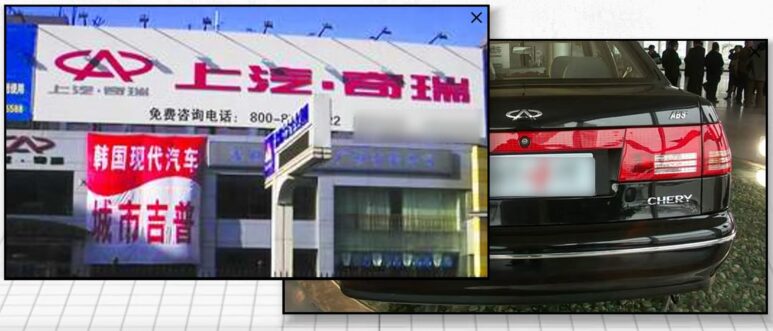VW vs. Chery: The “Copycat” Scandal That Forced SAIC to Pay Millions
The story of the Chinese automotive industry is a dramatic one, marked by rapid growth, fierce competition, and, in its early days, controversial “borrow-and-build” strategies. Today, as Chinese automakers like Chery aggressively expand their presence in Europe and the US, it’s worth revisiting a shocking lawsuit that laid bare the industry’s complex and often brutal origins.
In 2002, German giant Volkswagen sued a fledgling Chinese automaker named Chery for intellectual property infringement, demanding a staggering 120 million yuan in damages. The twist? Standing alongside Chery in the defendant’s box was an entirely different company: SAIC Motor, one of China’s most powerful state-owned automakers.
Why would SAIC, a company seemingly unrelated to Chery, be held financially responsible for a lawsuit brought against another firm? The answer lies in the name that adorned Chery’s early cars until 2004: “SAIC-Chery (上汽奇瑞).” This seemingly innocuous name tells the story of a strange, four-year partnership born out of desperation and ending in a bitter, multi-million-dollar settlement. This is the tale of how a “copycat” dispute revealed the fragile and often strained relationship between foreign and domestic players in China’s market.

Mission Impossible: Building a Car from Scraps
The journey begins in 1999 with Chery’s first model, the Fengyun. Back then, building a car was nearly impossible for a new private enterprise in China. But Chery’s leader, Yin Tongyue, had a secret weapon: over a decade of experience as a plant manager at FAW-Volkswagen.
- The Heart (Engine): Chery bought a defunct engine production line from Ford in the UK for a pittance. When foreign engineers struggled to set it up, Yin, a man of daring conviction, sent them home. “We’ll do it ourselves!” he declared. “If we fail, I’ll jump in the Yangtze River!” His gamble paid off, and within a year, they had their first working engine.
- The Skeleton (Chassis): The chassis was a far more audacious move. Chery acquired the vehicle platform from SEAT in Spain, a company that Yin knew had recently been acquired by Volkswagen. He was well aware that this platform was identical to the one used for the Volkswagen Jetta. A car with a Ford heart and a VW skeleton—this was the strange combination that would prove to be a ticking time bomb.
The Great Wall of “Production Qualification”
In December 1999, the Fengyun was complete. But a bigger problem emerged. At the time, only companies on the government’s “approved production list” could sell cars nationwide. As a newcomer, Chery was, of course, not on this list.
Chery tried unconventional methods to bypass this rule, such as replacing all the taxis in the city of Wuhu with Fengyun models to build brand recognition, or even “disguising” new cars as used ones to sell them in other provinces. But these were temporary fixes. Chery needed a legitimate license, and for that, it had no choice but to rely on a powerful giant.
The Reluctant Alliance: SAIC’s Four Years of Regret
In 2001, Chery gave SAIC a 20% stake in the company for free in exchange for the right to use the “SAIC-Chery” name. Despite receiving the shares at no cost, SAIC’s attitude was famously cold. They adopted a “Four No’s” policy: no investment, no involvement in management, no responsibility for risk, and no dividends.
It was as if an honor student had been forced to share a desk with a troublemaker, drawing a line down the middle of the table. But contrary to SAIC’s expectations, this “troublemaker” became a massive market success. In 2002, the Fengyun sold 28,000 units and was even exported to Syria.
SAIC began to regret its cold stance. At the time, SAIC’s biggest frustration was its lack of a proprietary brand, as its most profitable ventures were joint ventures with Volkswagen and GM. Too late, SAIC tried to increase its investment to turn Chery into a “son of its own,” but Chery, having been spurned, flatly refused. The emotional rift was too deep.
The Inevitable Explosion: VW’s Lawsuit and SAIC’s Tears
It was at this critical moment that the inevitable happened. Volkswagen’s German headquarters bought a Fengyun from the market, disassembled it, and was horrified to find a clear VW logo on the chassis. Chery, in its quest to cut costs, had been using the same parts suppliers as SAIC-Volkswagen, and components with the VW logo had been delivered directly to its assembly line.
Volkswagen initially tried to form a joint venture to learn from Chery’s cost-cutting expertise, but Chery refused. Rebuffed, VW immediately filed a lawsuit for intellectual property infringement.
Because the cars were branded “SAIC-Chery,” SAIC could not escape responsibility. SAIC executives flew to Germany and negotiated a settlement, agreeing to pay 30 million Deutsche marks (approximately 120 million yuan at the time) to resolve the dispute. This was a bitter pill to swallow for SAIC, which had to be reimbursed by Chery over the next two years.
To make matters worse, Chery’s other hit model, the QQ, was hit with a high-profile lawsuit from SAIC’s other partner, GM Daewoo (now GM Korea), for allegedly copying the Matiz. The two companies had reached a point of no return.
Four Years of Bitterness and Separate Paths
In 2004, with the relaxation of government regulations, Chery finally obtained its own production license, eliminating any reason to rely on SAIC. On September 30, 2004, SAIC returned its 20% stake to Chery, and the “SAIC-Chery” era ended after just four years.
Though Chery’s beginning was shrouded in “copycat” accusations and shadowed by a larger giant, this painful partnership taught the company how to survive and innovate. This strange co-habitation became the difficult but crucial growing pain that forged today’s global automaker. You can find more details about this historical event in a Financial Times report on the “resolved” dispute. 👉 CHINA: VW’s parts dispute with SAIC ‘resolved’, but raises uncomfortable issues – Just Auto
My AI Jazz Project: